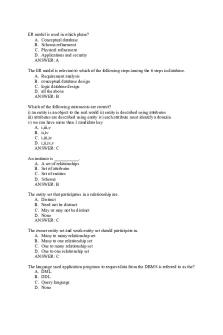Notes for CS 348 Exam - Summary Databases PDF

| Title | Notes for CS 348 Exam - Summary Databases |
|---|---|
| Author | Vishaal Bommena |
| Course | Databases |
| Institution | Purdue University |
| Pages | 2 |
| File Size | 38.3 KB |
| File Type | |
| Total Downloads | 20 |
| Total Views | 133 |
Summary
Professor was Walid Ahmed...
Description
●
● ● ● ●
●
●
●
● ● ●
Notes for CS 348 Exam University Example 1. Sid, cid, grade 2. Sid is key - Student can take at most one course 3. Cid is key - Course can be taken by at most one student 4. Cid, grade is key - For a given course, no two students can have the same grade 5. Sid, grade is key - A student can get the same grade 6. Grade is key - only one grade can be given in the entire university 7. Sid, cid, grade - A student can take the same course as long as the student does not get the same grade. SQL Turing complete- It is not equivalent to a Turing Machine. But PL/SQL is a Turing Complete. JDBC is Turing Complete. Data Definition Language: (SQL Example Create Table) Data Manipulation Language: (Insert/Delete/Select tuple) Levels of Data Management: ○ User Interface ○ Query Parser ○ Query Optimizer ○ Query Processor ○ Axis/Table Manager: How to access an attribute in a table ○ Memory and Buffer Manager ○ Disk management is the core of the Database Management. ■ Note: Management, Security and Concurrency manager is available across all the levels Integrity Constraints: To make sure the data is integral, consistent and remains valid. ○ Account balance not negative. ○ Attribute not being null ○ Phone Number being a null (Domain Constraints). ○ Unique Key/Foreign (Referential Integrity Constraints or Foreign Key Constraints) Mathematical Foundation of SQL: ○ Relational Algebra ○ Relational Calculus ○ Query By Example (QBE): Builds on Domain Relational Calculus. They are declarative. ○ SQL: Builds on Tuple Related Calculus. They are declarative. Entity Relationship Model: ○ Entity ○ Relationships ○ Attributes of the Relationship ○ The Arity of the Relationship (one to one, one to many and so on) ○ Key Constraints Note: Given schema and constraints and check whether a tuple violates constraints Note: May give two SQL Queries and ask whether they return the same values. Note: May give a sentence and ask to translate into SQL.
●
Note: May give scheme and a SELECT query and ask what the query will do....
Similar Free PDFs

Summary - notes for exam
- 4 Pages

CS 6400 Notes Exam 1
- 19 Pages

PDM Coded - MCQs for databases
- 7 Pages

CS Notes
- 9 Pages

CS 22A Summary Ch11
- 3 Pages

Midsem exam summary notes
- 15 Pages

Summary - Property Exam Notes
- 3 Pages

Exam notes - summary
- 82 Pages

Exam Summary Notes
- 23 Pages

Summary Notes for MT3006
- 12 Pages

Cs 1101 final exam
- 12 Pages
Popular Institutions
- Tinajero National High School - Annex
- Politeknik Caltex Riau
- Yokohama City University
- SGT University
- University of Al-Qadisiyah
- Divine Word College of Vigan
- Techniek College Rotterdam
- Universidade de Santiago
- Universiti Teknologi MARA Cawangan Johor Kampus Pasir Gudang
- Poltekkes Kemenkes Yogyakarta
- Baguio City National High School
- Colegio san marcos
- preparatoria uno
- Centro de Bachillerato Tecnológico Industrial y de Servicios No. 107
- Dalian Maritime University
- Quang Trung Secondary School
- Colegio Tecnológico en Informática
- Corporación Regional de Educación Superior
- Grupo CEDVA
- Dar Al Uloom University
- Centro de Estudios Preuniversitarios de la Universidad Nacional de Ingeniería
- 上智大学
- Aakash International School, Nuna Majara
- San Felipe Neri Catholic School
- Kang Chiao International School - New Taipei City
- Misamis Occidental National High School
- Institución Educativa Escuela Normal Juan Ladrilleros
- Kolehiyo ng Pantukan
- Batanes State College
- Instituto Continental
- Sekolah Menengah Kejuruan Kesehatan Kaltara (Tarakan)
- Colegio de La Inmaculada Concepcion - Cebu




